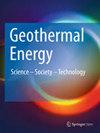A three-dimensional hydraulic-thermal model has been developed for the island of Pantelleria in order to investigate the driving heat transfer mechanisms and the role of rocks and fluids thermal and hydraulic properties in controlling the temperature distribution. The model simulates transient conditions accounting for changes with time of the background steady-state thermal field over a period of 50,000 years, which coincides with a period of major morphological/structural stability on the island. The comparison between observed and computed temperatures was used to validate the model. Model outcomes confirm temperature up to 490 °C at 2 km depth in the central part of the Cinque Denti caldera. The proposed thermal modeling agrees with the trend of the thermal anomaly on the island, clearly evidencing how the center of the thermal anomaly is located within the young caldera, while the north-eastern part of the island is characterized by much lower temperatures than its central-southern part. It is shown that a coupled thermal–hydraulic 3D model can provide a clear perspective on surface and subsurface conditions that drive heat transfer, thus helping to understand the characteristics of geothermal systems in the area.


